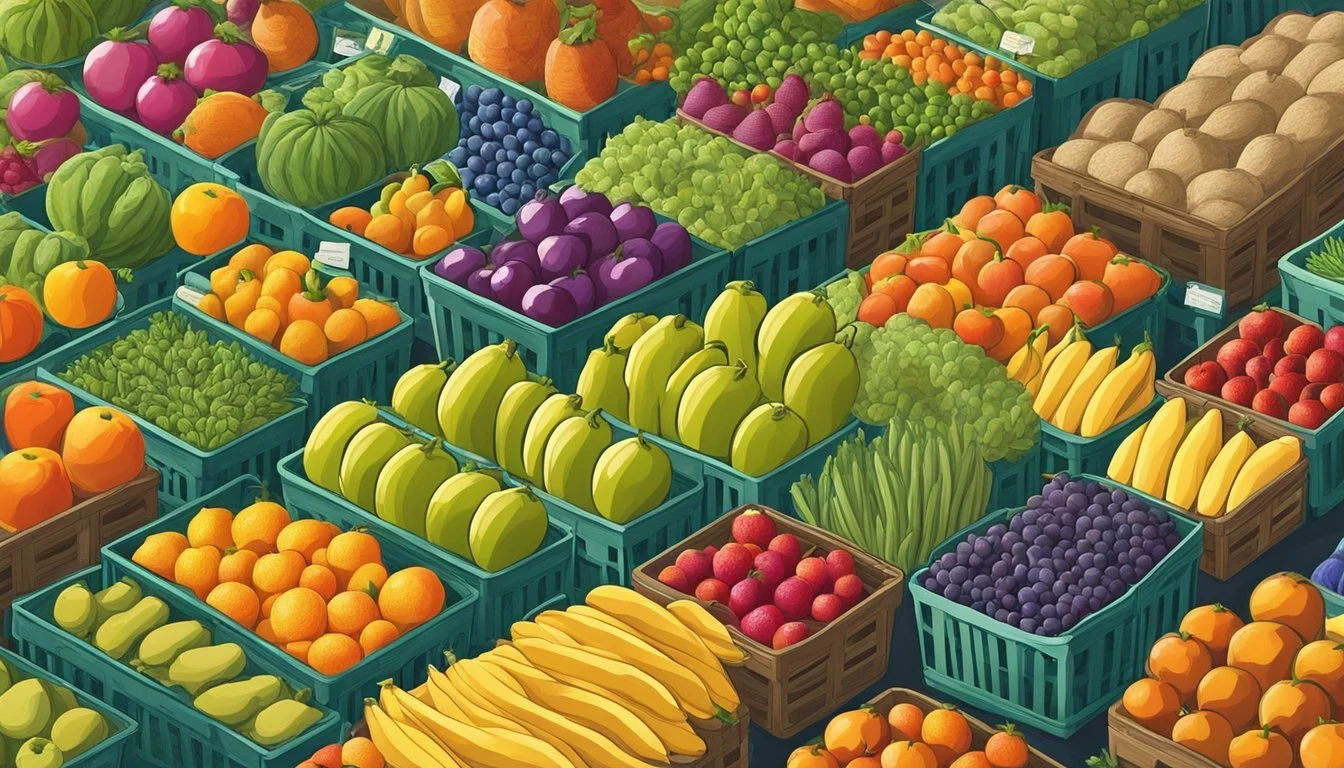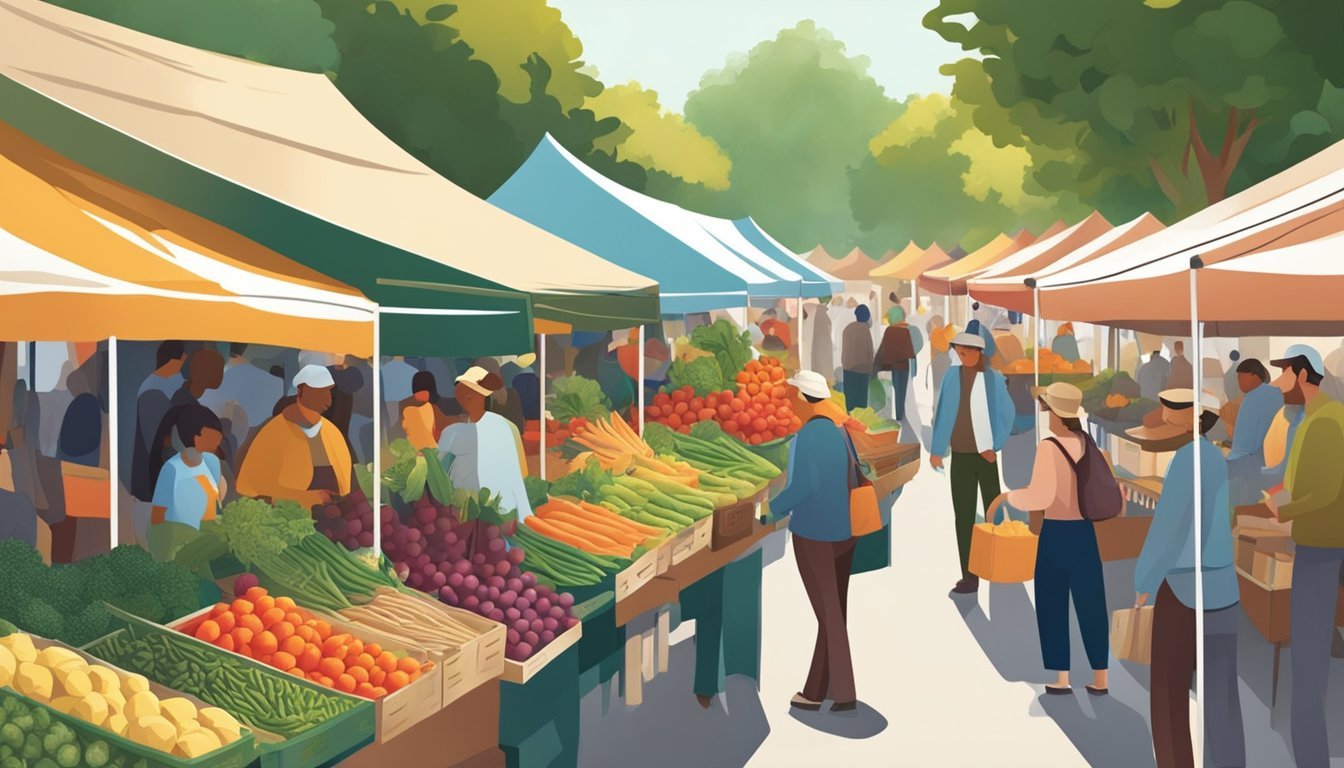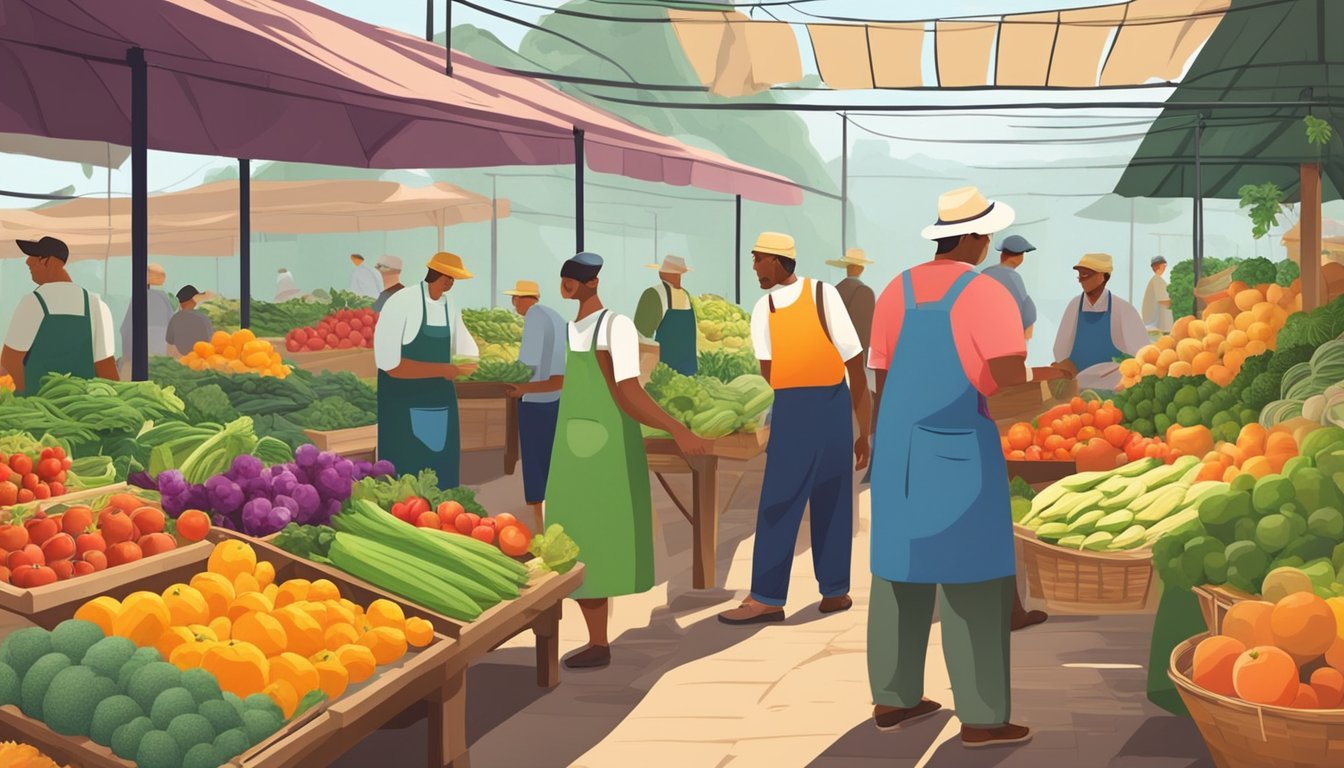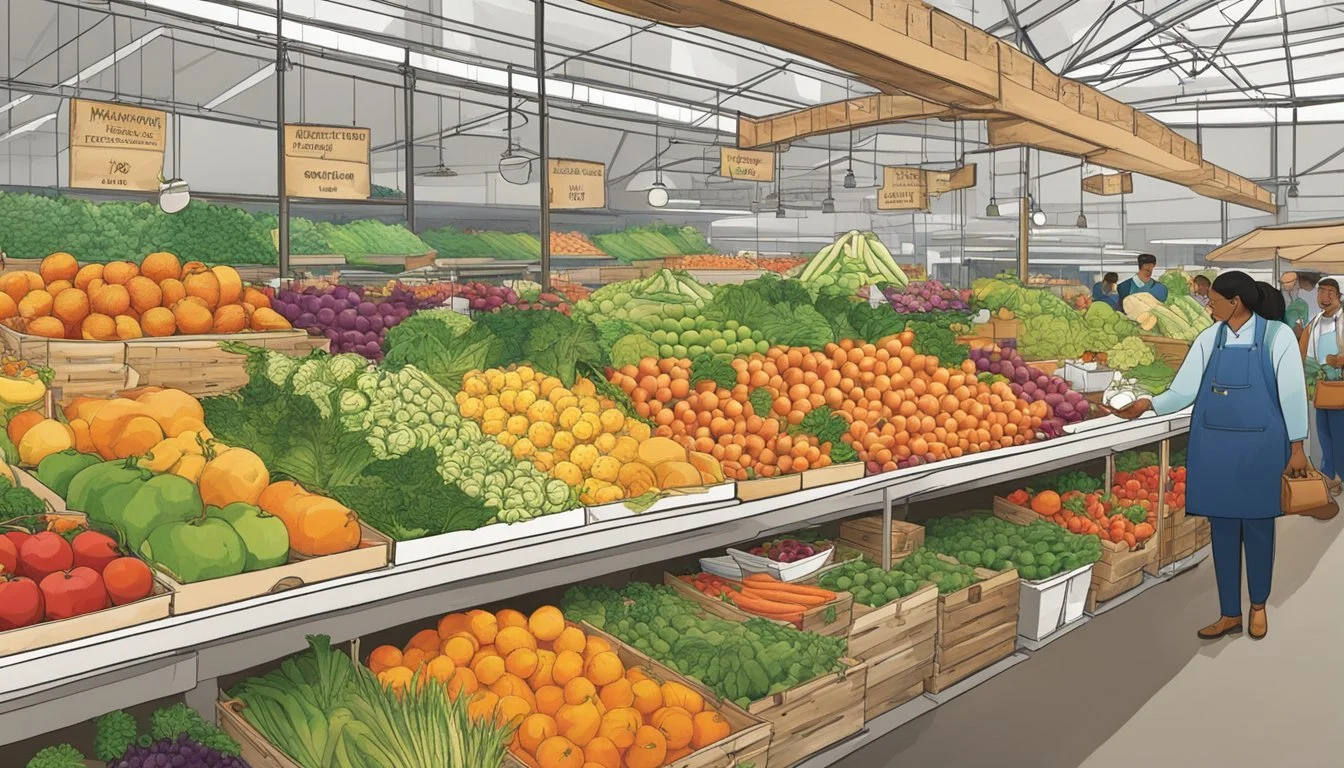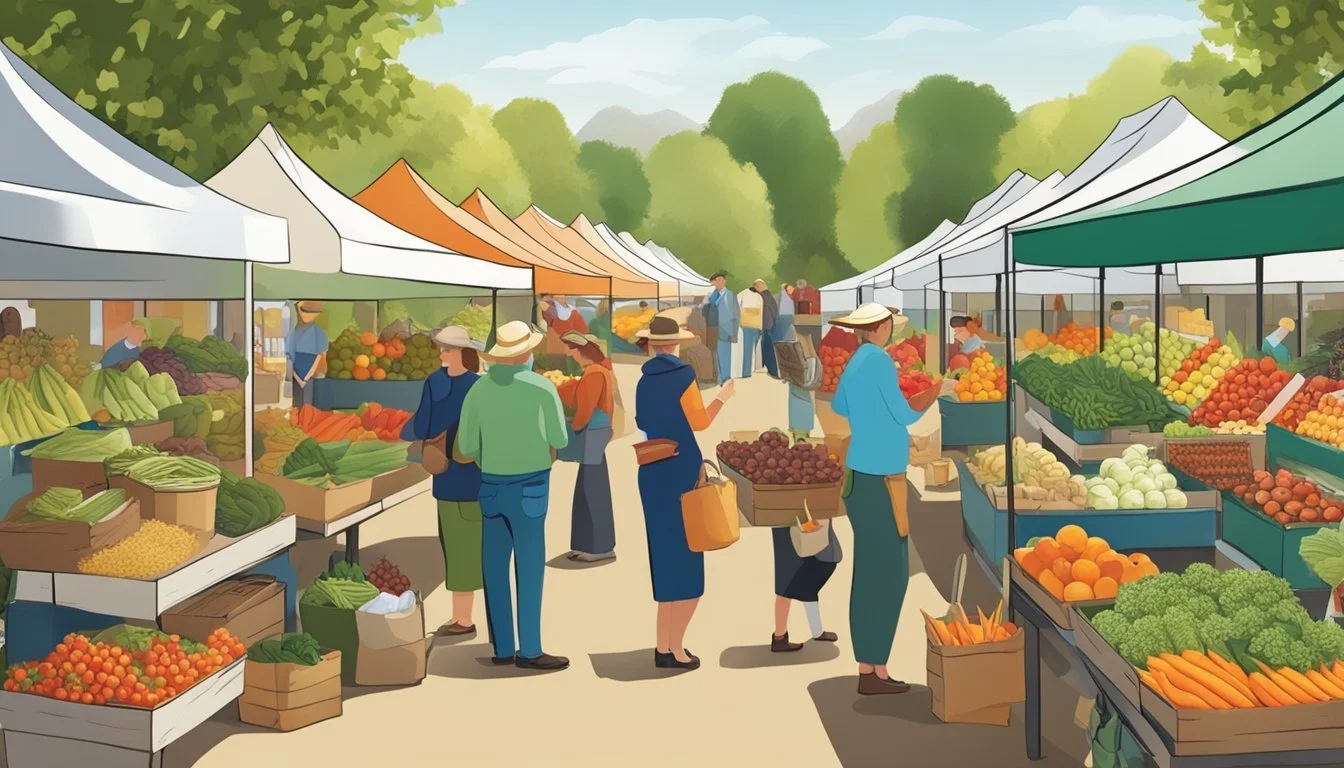Understanding Seasonal Cycles at the Farmers' Market
A Guide for Shoppers
Farmers' markets function as hubs for fresh, locally-grown produce, providing access to a variety of fruits, vegetables, and other farm products that change with the seasons. The array of available goods shifts throughout the year, reflecting the agricultural cycles and regional climate. Shoppers at these markets can taste the peak of freshness and nutrition, as seasonal produce is harvested at the optimal time for flavor and nutrient content. To make the most of a farmers' market experience, one must understand the seasonal cycles that determine the availability of produce.
Understanding seasonal cycles involves recognizing that different produce items have specific growing seasons, and these can vary by region. For instance, in many areas, one can expect to find leafy greens such as spinach and kale during cooler months, while summer brings a bounty of tomatoes, peppers, and stone fruits like peaches and nectarines. In the spring, markets are often filled with an array of young vegetables, including tender peas, spring onions, and leeks that infuse dishes with their delicate flavors. Since the offerings at farmers’ markets directly reflect local harvests, shoppers are simultaneously supporting regional agriculture and getting the freshest food possible.
Becoming familiar with these patterns not only enriches the shopping experience but also encourages healthier eating habits and supports sustainable practices. By purchasing seasonal produce, consumers help reduce the carbon footprint associated with transporting food over long distances, and they contribute to local economies. Knowledge of seasonality guides helps consumers plan their meals around what is fresh, integrating a variety of nutrient-rich foods into their diets at the times when those foods are most beneficial and delicious.
Essence of Seasonal Cycles
Seasonal cycles are deeply ingrained in the rhythm of agriculture, with natural cycles shaping the planting, growing, and harvesting timelines. The Earth's tilt and orbit around the sun cause seasons to change, creating seasonal patterns in weather conditions. This, in turn, influences farm productivity throughout the year.
Key Aspects:
Natural Cycles: The rotation and revolution of the Earth result in varying amounts of sunlight and temperatures, dictating when certain crops can be grown.
Seasonal Patterns: Specific climate patterns, such as monsoons or frosts, can be anticipated, allowing farmers to plan their activities accordingly.
Productivity: Farming productivity peaks during optimal seasons, when conditions are perfect for crops to flourish.
Farmers align their activities with these cycles to maximize yield and ensure sustainability. For instance, the onset of spring signals a time for planting many types of produce, while fall often marks the harvest season for mature crops. Each crop's lifecycle is sensitive to climatic changes, demanding careful timing to achieve a successful harvest.
Spring: Planting and early growth; preparation for summer.
Summer: Peak growth; heightened maintenance and monitoring.
Autumn: Harvesting; beginning of soil preparation for the next cycle.
Winter: Dormancy for some crops; planning and repair of equipment.
Farmers' markets reflect these cycles, as the availability of fresh produce ebbs and flows with the seasons. Customers at these markets experience the richness and diversity of fresh, locally grown produce that is at its peak, both in terms of flavor and nutritional value, adhering to the rhythms of nature.
Market Dynamics
The interplay of supply and demand directly attributes to the pricing fluctuations and profitability within farmers' markets. Here, both consumer preferences and market forces coalesce, framing the financial landscape for producers and vendors.
Supply and Demand
Supply levels at farmers' markets typically vary with seasons, climatic conditions, and growers' capacity. Demand, on the other hand, shifts due to consumer needs, cultural trends, and dietary shifts over time. Supply often sees a spike in harvest periods, leading to an increased product availability at the market. Conversely, when demand peaks, often due to seasonal festivals or health trends, it can lead to shortages and increased prices.
Prices and Profitability
The prices of goods at a farmers' market are a direct reflection of the existing supply and demand balance. Profitability for vendors hinges on strategically setting prices to cover costs while remaining attractive to consumers. Markets experience periodic price surges, especially when products are scarce or in high demand due to seasonal preferences or events.
Consumer Preferences
Consumer preferences shape the farmers' market landscape significantly. Buyers tend to look for fresh, seasonal produce, valuing the quality and origin of their purchases. This demand influences the market's inventory, as vendors cater to preferences with the aim of maximizing profitability. Trends such as organic produce or locally-sourced goods can command higher prices due to consumer willingness to invest in preferred attributes.
Farmers' Strategies
Farmers employ a wide range of strategies to navigate the seasonality of the farmers' market. These strategies are aimed at maintaining a steady supply, meeting market demand, and maximizing profitability throughout the year.
Crop Diversification
Farmers employ crop diversification to spread risk and ensure a consistent presence at the market throughout various seasons. This involves cultivating a variety of crops that have different planting and harvesting times, adapting to consumer preferences, and adjusting to market demand. For example, a farmer might grow root vegetables that can be sold in late autumn and winter while also raising leafy greens that are harvested in spring.
Spring: Cultivation of leafy greens, peas, and berries.
Summer: Harvesting of tomatoes, cucumbers, and stone fruits.
Autumn: Availability of root vegetables and apples.
Winter: Sale of stored produce and winter crops such as squash.
Production and Harvesting Techniques
Innovative production and harvesting techniques are crucial to extend growing seasons and bring fresh produce to the market year-round. Farmers might use greenhouses or high tunnels to protect crops from harsh weather, allowing for an extended or possibly year-round growing season. They prioritize crops that can withstand storage, such as onions and potatoes, to maintain supply when harvesting is not feasible.
Greenhouses: Facilitate cultivation in off-season periods.
Storage: Selection of crops that have a longer shelf life post-harvest.
Market Analysis and Forecasting
Effective market analysis and forecasting enable farmers to align their production with future market trends. They analyze data on seasonal price patterns, recognizing when prices typically rise and fall, to optimize the timing of their crop sales. Farmers also consider historical consumer demand and potential shifts, such as an increase in demand for locally produced, organic produce, which can dictate both crop selection and planting schedules.
Historical Data: Used to predict price trends and consumer demand.
Market Demand: Research into local consumer preferences and potential shifts in demand.
By implementing these strategies, farmers within the agricultural sector improve their odds of succeeding in a market governed by seasonality and changing consumer trends. These approaches allow them to maintain economic stability and meet the evolving needs of the market confidently and effectively.
Crops and Seasons
Farmers' markets reflect the natural ebb and flow of the growing season. With each season comes a new crop selection that is best suited to the current climate and soil conditions.
Winter Crops
In winter, the selection narrows but can still include hardy vegetables. Root vegetables like carrots and beets thrive in the cold, storing well through the season. Leafy greens such as kale and spinach can survive frost, offering fresh produce even in cooler temperatures.
Spring Crops
The arrival of spring heralds the beginning of pea and radish planting, with their quick growing cycles making them among the first to be harvested. Spinach and lettuce are also ready for harvest, while rhubarb starts to peek through the soil, adding a tart option to the market.
Summer Crops
Summer is the peak of abundance with a variety of colorful and flavorful choices. This season is known for tomatoes, cucumbers, and peppers, bringing vibrancy to the market stalls. Fruits like blueberries enter their prime, and corn stands tall with its sweet, juicy kernels.
Autumn Crops
Autumn is a time of transition, offering the last of the summer crops like tomatoes, while introducing those that thrive in cooler weather, such as broccoli, cauliflower, and brussels sprouts. Staple grains, including wheat and soybeans, are typically harvested before the first frost.
Animal Husbandry
Animal husbandry at farmers' markets is characterized by a keen understanding of the seasonal cycles that influence livestock production. Seasonal variations in supply and demand are influenced by a variety of factors that tend to follow an annual pattern.
Spring typically marks an increase in births among livestock. For chickens, this is a time for laying eggs and brooding. Farmers plan for egg production to peak in alignment with the increased market demand. In the case of pork, farmers pay attention to farrowing schedules as sows give birth to piglets. This preparation allows a steady flow of product availability at the market.
Summer brings a surge in consumer demand for meats, especially for outdoor grilling activities. Farmers take this opportunity to market a higher quantity of chicken and pork. They manage their stocks to ensure they can meet the climb in demand without overextending their resources.
Autumn sees some farmers planning for herd reductions, as colder weather approaches and feed prices potentially rise. This reduction is strategically timed as it leads to an increase in the meat supply available for consumers looking to stock up for the winter months.
Winter is often a leaner period in terms of births and production. Farmers need to provide adequate shelter and warmth for their animals, ensuring their welfare, which might result in slightly higher costs reflected in market prices.
Here is a concise summary of key considerations for poultry and pork produced through seasonal cycles:
Chicken: Egg production and brooding in spring, peak meat demand in summer, preparation for winter sustenance.
Pork: Farrowing aligned with market demands, allowance for growth to meet summer demand, strategic herd reduction in autumn.
Farmers adept at navigating these cycles can ensure animal welfare, meet consumer demands, and optimize their economic outcomes.
Environmental and Economic Impact
Farmers' markets play a pivotal role in promoting sustainability and reducing the carbon footprint associated with food production, positively impacting both local and global economies.
Sustainability Practices
Farmers' markets provide a platform for local farmers to adopt and showcase sustainable agricultural practices. They often involve reduced transportation needs for produce, leading to lower carbon emissions. Producers at these markets typically engage in crop rotation and organic farming, enhancing soil health and biodiversity, which are crucial components of environmental stewardship.
Climatic Influences
The agricultural production cycle is closely linked with seasonal climatic patterns. By aligning planting and harvesting schedules with the seasons, farmers can optimize natural resource use and mitigate the effects of adverse weather on crops. This alignment contributes to environmental conservation and improves food security by maintaining a consistent supply of fresh produce throughout the year.
Local and Global Economy
Farmers' markets have a significant influence on both the local and global economy. Locally, they help keep financial resources within the community, supporting local farmers and businesses which can lead to economic growth. On a global scale, reduced reliance on long-distance transportation helps to decrease the overall carbon footprint of the food supply chain, making a positive impact on global environmental health. Sustainable practices adopted by local producers resonate with global initiatives aimed at enhancing food security and environmental sustainability.
Role of Technology and Innovation
In the realm of farmers' markets, technology and innovation play a pivotal role in understanding and navigating seasonal cycles. Research in agricultural technology has led to the development of connected sensors and artificial intelligence (AI) systems that help farmers monitor and predict environmental changes affecting seasonal produce availability.
Productivity gains are notable as these technologies enable farmers to optimize planting schedules and irrigation systems, resulting in higher crop yields. For example, they use analytics to understand soil composition and weather patterns, which can determine the best times to plant and harvest.
When it comes to labor, innovations such as automation and machine learning have streamlined many farming processes. Tasks that traditionally required manual labor, such as field inspection and data collection, are increasingly automated, allowing for real-time data analysis and more efficient resource allocation.
Data-Driven Decisions: By leveraging technology, farmers better understand which crops to grow each season and how to manage their resources effectively.
Innovation in Agriculture: New technologies have also spurred innovation in cultivation techniques and crop management, reducing the impact of pests and diseases on seasonal yield.
Indeed, as these advancements gain traction, the farmer's market landscape is transforming. Vendors can provide consumers with fresher, more abundant produce by leveraging these technological enhancements, thereby reinforcing the sustainability and resilience of local agriculture.
Understanding Financial Aspects
In the seasonal swings of farmers' markets, financial consistency is often a challenge. Farmers, investors, and traders alike must navigate profitability while contending with fluctuating production costs and commodity prices.
Investors' Interests
Investors are particularly keen on gauging profitability through the lens of seasonal trends. They scrutinize corn prices as an indicator of agricultural performance, often entwined with a broad spectrum of commodity stocks. Assessing financial health involves comparing quarterly reports and predicting returns based on market analysis.
Hedging Mechanisms
Producers employ hedging to mitigate risks associated with volatile markets. Using hedging mechanisms such as futures contracts, a farmer can lock in corn prices to stabilize potential income. This financial tool is critical for producers looking to safeguard their profits against unforeseen market shifts.
Evaluating Stocks and Profits
When traders evaluate agriculture-related stocks, they consider both the current profitability and the potential for future gains. A comprehensive assessment includes:
Analysis of production costs vs. market price trends.
Historical data to inform future performance projections.
Impact assessment of external factors like weather on crop yields.
Through meticulous evaluation, traders and investors aim to optimize their financial positions within the agricultural sector.
Adapting to Weather Variabilities
In the context of farmers' markets, adapting to weather variabilities is essential for ensuring a stable supply of produce. Farmers must understand and respond to changes in growing seasons and weather conditions to maintain crop yields and quality.
Temperature Effects on Harvest
Temperature shifts play a pivotal role in the duration and quality of growing seasons. Rising temperatures can lead to earlier harvests, making certain crops available sooner at the farmers’ market. However, extreme heat can also stress plants, potentially reducing yields. Farmers are responding by selecting crop varieties suited to warmer climates and adjusting planting schedules.
Examples of adaptation strategies include:
Planting dates: Adjusting the timing to align with temperature changes.
Crop selection: Choosing varieties that thrive in altered temperature ranges.
Dealing with Unpredictable Weather
Unpredictability in weather conditions, such as erratic rainfall or unexpected frosts, requires farmers to be flexible and innovative. They utilize a mix of traditional practices and modern technology to respond to real-time climatic conditions. This includes the use of weather forecasts to plan ahead and implement proactive measures such as irrigation systems or protective covers.
Tactics to counter unpredictable weather:
Irrigation systems: Ensuring consistent water supply during dry spells.
Protective structures: Using greenhouses or row covers to shield crops from extreme elements.

